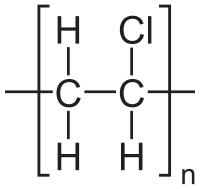Die folgende Tabelle gibt eine Übersicht über verbreitete Polymere und deren Eigenschaften. Dabei steht MST für "maximum service temperature" (maximale Gebrauchstemperatur), "krist." steht für kristallin oder amorph oder den Grad an Kristallinität, Tg/Tm steht für Glastemperatur Tg oder Kristallitschmelztemperatur Tm, €/kg steht für den Durchschnittspreis 2013 in €/kg.
| Name | Kurzform | Struktur | €/kg | krist. | Tg/Tm °C | MST | Dichte in g·cm−3 | Zugfestigkeit EN ISO 527-1 in N·mm−2 | Bruchdehnung EN ISO 527-1 in % | E-Modul EN ISO 527-1 in N·mm−2 | Sauerstoffindex | Durchschlagsfestigkeit in kV·mm−1 | Unbeständig gegen |
|---|---|---|---|---|---|---|---|---|---|---|---|---|---|
| Polyamidimid | PAI | 
|
amorph | 290 °C | 240 °C | 1,4 | 3–10 | 4.500–6.200 | 45 | 22 | |||
| Acrylnitril-Butadien-Styrol | ABS | 2,2–2,3 | amorph | 1,02–1,25 | |||||||||
| Polycaprolactam | PA6 | 
|
3,2 | teilkristallin | 228 °C[1] | 150 °C[2] | 35[2] | ||||||
| PA 66 | PA6.6 | 3,7 | teilkristallin | 269 °C[1] | 1,13–1,14 | ||||||||
| Polybutylenterephthalat | PBT | 3,7 | teilkristallin | 269 °C[1] | 1,13–1,14 | ||||||||
| Zum Vergleich: Stahl St52 | 0,5 | 7,85 | 510 | 22[3] | 210.000 | ||||||||
| Low density polyethylen | PE-LD | 
|
40-60 %[1]:29 | -100/105-115[1]:43 | 90 °C[1]:29 | 0,915 - 0,933[1]:29 | 3-56[1]:29 | 13-400[1]:44 | 140-1000[1]:44 | ||||
| Linear low density polyethylen | PE-LLD | 
|
55 - 65 %[1]:29 | -100/120-130[1]:43 | 95 °C[1]:29 | 0.92 - 0.94[1]:29 | 8-45[1]:29 | 8-30[1]:44 | 110-1200[1]:44 | ||||
| High density polyethylen | PE-HD | 
|
70 - 90 %[1]:29 | -100/130-138[1]:43 | 100 °C[1]:29 | 0.93-0.97[1]:29 | 10-43[1]:29 | 6-45[1]:44 | 180-1800[1]:44 | ||||
| Polybuten-1[4] | PB-1 | 
|
teilkristallin | /98.0-126[1]:45 | 95 °C[1]:35 | 0.91[1]:35 | 0.5-2.4[1]:35 | 300-550[1]:45 | 290–295 MPa [4] | ||||
| Polypropen Homo | PP Homo | 
|
-5/-[1]:44 | [1]:44 | 0,90-0,91[1]:44 | 35-40[1]:44 | 1200-2000[1]:44 | ||||||
| Polypropen Copo | PP Copo | 
|
-20/-[1]:44 | 0.90-0.91[1]:44 | 20-35[1]:44 | 1000-1500 MPa [4] | |||||||
| Polypropen Impact | PP Impact | 
|
-35/-[1]:44 | 0.90-0.91[1]:44 | 11-28[1]:44 | 500-1200 MPa [4] | |||||||
| Polyvinylchlorid | PVC | 
|
amorph |
Einzelnachweise Bearbeiten
- ↑ a b c d e f g h i j k l m n o p q r s t u v w x y z aa ab ac ad ae af ag ah ai aj ak al am an Kutz - Applied Plastics Engineering Handbook
- ↑ a b c http://www.biomaterialienkatalog.de/drucken/index.php?katalog=polymere&id=535
- ↑ http://www.maschinenbau-wissen.de/skript/werkstofftechnik/stahl-eisen/37-baustahl
- ↑ a b c d Andrew Freeman, Susan C. Mantell, Jane H. Davidson: Mechanical performance of polysulfone, polybutylene, and polyamide 6/6 in hot chlorinated water. In: Solar Energy. 79. Jahrgang, Nr. 6, 2005, S. 624–37, doi:10.1016/j.solener.2005.07.003.